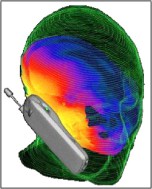NTP cell phone studies — experts recommend elevated conclusions
A group of scientists examining the data and results from the (USA) National Toxicology Program‘s (NTP) study of the impact of cell phone radiation on rats concluded that there is clear evidence that exposure to microwave radiation caused cancer in rat hearts. They recommended that the NTP change its draft descriptions of the study’s findings to reflect this and other conclusions, such as “some evidence” for malignant glioma and tumors in the adrenal glands. The NTP had used politically correct language skewing its findings, downplaying the actual results, to seemingly favor the wireless industry, as has often been seen in United States government agencies for at least twenty years. It should be noted that microwave radiation, such as is emitted by cell phones, is also emitted by other wireless devices, cell towers, wifi, home security systems, smart utility meters, baby monitors, and microwave ovens, though this particular study examined microwave radiation exposure as emitted by cell phones.
from this article:
“Heart, brain, and adrenal tumors
Working from the NTP scale of clear evidence, some evidence, equivocal evidence, and no evidence, the panel made several recommendations.
The experts recommended that tumors in tissues surrounding nerves in the hearts of male rats, called malignant schwannomas, be reclassified from some evidence to clear evidence of carcinogenic activity [emphasis added by CEP].
In female rats, they recommended reclassification of malignant schwannomas from no evidence to equivocal [potential] evidence of carcinogenic activity. The panel agreed that there were unusual patterns of cardiomyopathy, or damage to heart tissue, in exposed male and female rats.
“When I look at these types of studies, I look for high-level signals that can infer mechanisms. I have more questions than answers, but the heart is clearly sending a signal in the rat studies, between the levels of cardiomyopathy and malignant tumors,” said panelist Rick Adler, D.V.M., Ph.D., senior director of discovery and regulatory pathology for GlaxoSmithKline.
The panel recommended that findings for a type of brain tumor, called malignant glioma, and a tumor in the adrenal gland, called pheochromocytoma, be reclassified as some evidence of carcinogenic activity in male rats [emphasis added by CEP]…”
to read the entire article, click here
——————————————————-
[Key to Definitions of Carcinogenicity Results]
Clear Evidence of Carcinogenic Activity is demonstrated by studies that are interpreted as showing a dose-related (i) increase of malignant neoplasms, (ii) increase of a combination of malignant and benign neoplasms, or (iii) marked increase of benign neoplasms if there is an indication from this or other studies of the ability of such tumors to progress to malignancy.
Some Evidence of Carcinogenic Activity is demonstrated by studies that are interpreted as showing a chemical-related increased incidence of neoplasms (malignant, benign, or combined) in which the strength of the response is less than that required for clear evidence.
Equivocal Evidence of Carcinogenic Activity is demonstrated by studies that are interpreted as showing a marginal increase of neoplasms that may be chemically related.
No Evidence of Carcinogenic Activity is demonstrated by studies that are interpreted as showing no chemical-related increases in malignant or benign neoplasms.
Inadequate Study of Carcinogenic Activity is demonstrated by studies that because of major qualitative or quantitative limitations cannot be interpreted as valid for showing either the presence or absence of carcinogenic activity.



Comments are closed.